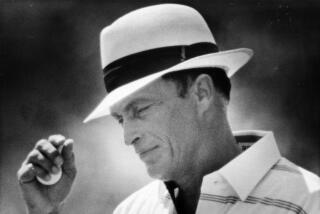BURNOUT : Chang Could Be Its Next Victim
NEW YORK — Three days ago, Michael Chang was a talented teen-age tennis player, a 15-year-old who had pulled off a rather remarkable feat by beating several 18 year olds in August to win the U.S. Junior championships.
Then he became the youngest male to win a match at the U.S. Open in almost 70 years. Suddenly, he was a celebrity. Suddenly, the top management groups began buzzing around. Suddenly, he was talking about turning pro.
“It would be a huge mistake,” Jim Loehr said. “If he turns pro, then tennis becomes his job at 15. You deny him the chance to be a kid, to be an adolescent. That’s what happens with tennis players. They go straight from being children to being adults. And it hurts them later in life.”
Loehr is a sports psychologist, who has studied the now-familiar phenomenon of tennis burnout for the last two years. He is also part of a new development program.
Eight years after 11 of the top 16 men in the world were Americans, only Jimmy Connors and John McEnroe remain in the top 10 with no sure-fire top tenners in sight. Americans are not winning Grand Slam tournaments--the last was McEnroe here in 1984--and they are losing Davis Cup matches by the bunch.
So, the USTA has turned to people like Loehr and Arthur Ashe and Tom and Tim Gullikson for help. “A lot of the things we’re saying aren’t new,” Loehr said. “But, now, people are listening because we’re losing.”
Burnout is nothing new in tennis. Everyone knows what happened to Tracy Austin and Andrea Jaeger. More recently, Jimmy Arias and Aaron Krickstein became top 10 players very early in their careers, only to slide into obscurity shortly thereafter. Now though, finally, the USTA thinks it is time to protect the next generation of Austins and Kricksteins from themselves and, perhaps more importantly, from the adults in their lives.
“So many parents totally mortgage their present for the future by spending huge amounts of money on their kids,” Loehr said. “When they do, there’s a hidden message: ‘I expect a return for this.’ It becomes a business at a very young age. The kid starts thinking, ‘God, I lost in the first round again and it’s costing my folks so much money to have me out here.’
“This is a problem unique to Americans. In Europe, the government does so much to support the young players once they’ve been identified that there isn’t the same kind of pressure. The parents aren’t in the picture so much because it isn’t their money.”
The 23-member committee has recommended to the USTA that the national 12-and-under and 13-14-year-old championships be discontinued beginning next year. Studies show that, historically, players who are champions at that age do not go on to become champions later.
“They develop a certain kind of game and they’re afraid to change it,” Tom Gullikson said. “There’s so much pressure to win, even at the age of 10 or 11 that kids don’t want to try anything new. They end up pushing (not hitting) the ball. You don’t become a champion that way. Look at Billy Martin. When he was a teen-ager, everyone thought he was going to be Jimmy Connors. He never came close.”
Connors, who is an exception to all these rules, remembers players he came up with who were finished with tennis by their early 20s. It just wasn’t called burnout then. “They were great players at 15 or 16,” he said. “By the time they turned pro, they had had enough, though. They were done.
“I think a kid like Chang, any kid that age should have an adolescence. I think that’s important. When you’re 15, you’re a baby. You haven’t done 90% of the things you’re going to do. If he’s talented, play some tournaments, that’s great. But don’t go too fast.”
Going too fast is the biggest danger in tennis. There is so much money to be made whenever a young player--especially an American in today’s environment--flashed some potential. Arias and Krickstein are both millionaires. But, in all likelihood, neither will ever reach his peak as a tennis player.
“The money is a big problem,” Loehr said. “It’s huge and it’s right there and it’s easy. People look short term, not long term. We want people to think long term.”
Gullikson agrees. “The problem we have with young players is that none of them have a Plan B,” he said. “They learn to play one way and if that isn’t working on a given day, they won’t change or adjust. They’re afraid to. The kids, the really talented ones especially, need better teaching. But money becomes a problem again. You want to get a tennis lesson in New York it’ll cost you $50. How many people can afford that?”
Getting more youngsters who are not from affluent backgrounds playing tennis is a theme that McEnroe and Ashe and others have hammered on for years. Black kids especially shy away from tennis. The development report recommends a program for black coaches, one that will enable black players to learn the game without having to become part of a white country club world.
“One of the things we’ve found is that if you pull a kid, any kid out of his natural environment, he isn’t going to be happy,” Loehr said. “We need black coaches who can teach the kids the game without making them part of a brand-new environment where they aren’t comfortable.”
Gullikson compares that with bringing teen-agers onto the men’s tour. “A lot of the teen-agers were ready to play tennis on the pro level,” he said. “But they weren’t ready for the tour socially. The young players need a chance to develop socially too. If they aren’t happy playing tennis, they aren’t going to be good tennis players.”
The new USTA program will take money. It will cost money to train coaches and to identify top players who should receive help either financially or in coaching or in terms of the advice they--and their parents--receive.
The answers are much harder to find than the questions. It is easy to see that many mistakes have been made that over-anxious parents and coaches have hurt many young players. Everyone knows the wrong way. Now, at last, the USTA is beginning to look for the right way.
More to Read
Go beyond the scoreboard
Get the latest on L.A.'s teams in the daily Sports Report newsletter.
You may occasionally receive promotional content from the Los Angeles Times.










